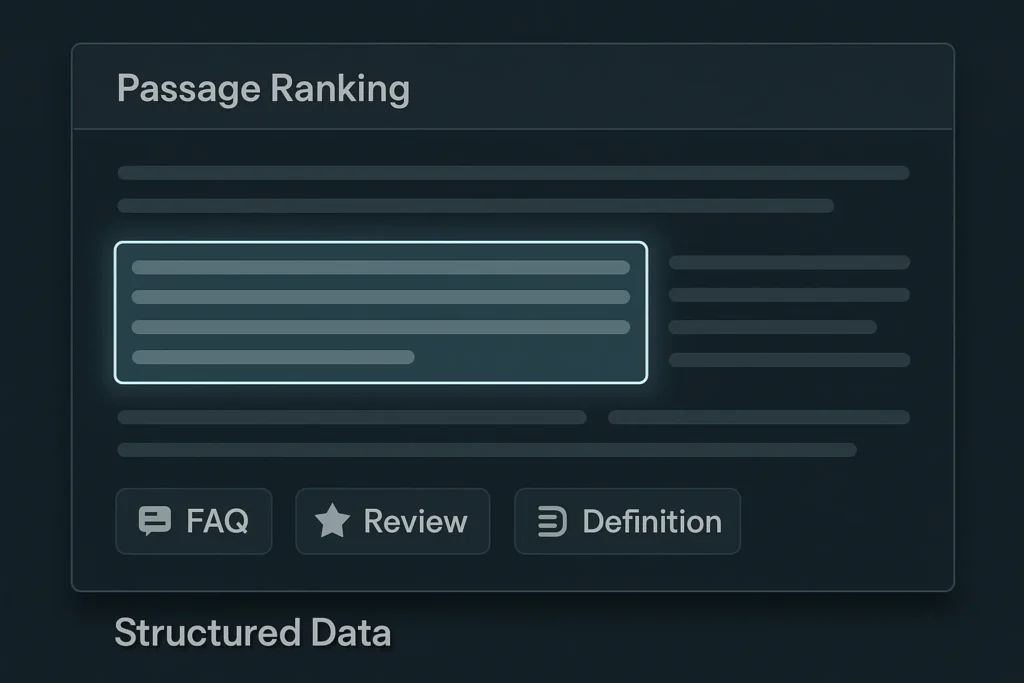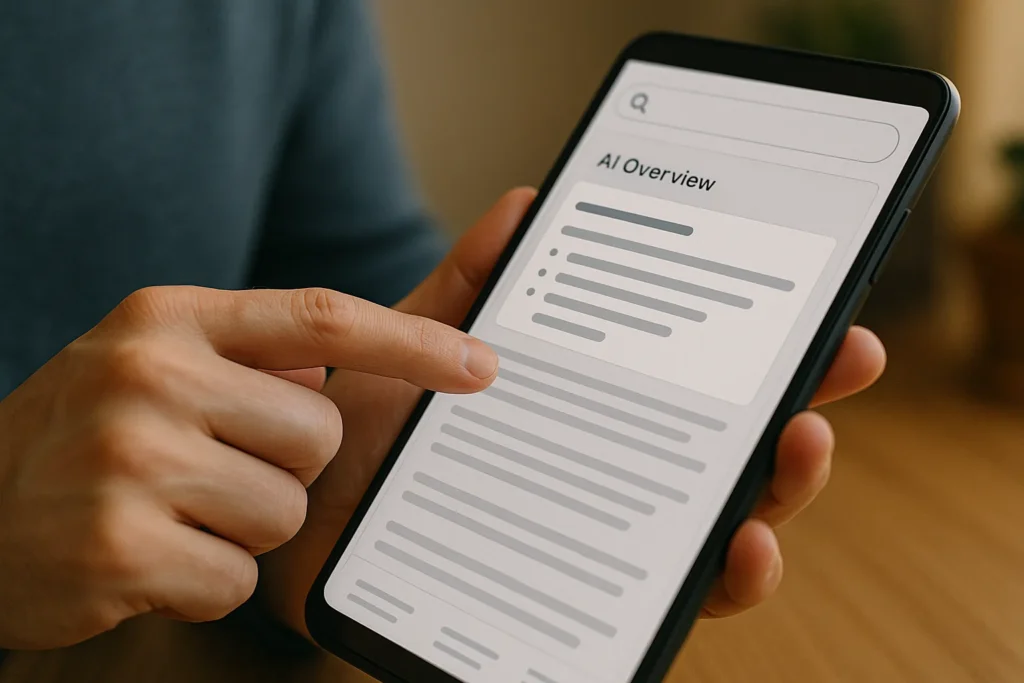Friday
18 JulHow Google’s SGE (Search Generative Experience) Will Impact Rankings
Imagine pouring hours into SEO only to find your site pushed even further down the page by content Google generated itself. Many businesses are facing this problem in 2025 as Google’s Search Generative Experience (SGE) is reforming what users see when they search.
Instead of the usual ten blue links, users now see AI-generated summaries, suggested follow-up questions, and fewer organic results (if any). It’s a major change. And if your SEO strategy still focuses on rankings alone, you might be invisible on the web.
This post will cover exactly how Google SGE 2025 is impacting visibility, what influences placement in AI Overviews, and how to future-proof your content. If your traffic has dropped recently or you’re planning ahead, this guide will help you refocus your SEO effectively.
Ready to see what’s transforming search results? Let’s begin.
How Google’s SGE Works in Search Results
SGE changes how results appear by using AI to generate summaries right on the search page. It saves users the step of clicking through to individual websites.
Rather than simply copy-pasting, this process involves Google’s AI rewriting important parts from top websites into one clear answer. This helps users get quick facts, but fewer people now scroll down to visit the original websites.
These AI Overviews now dominate the first page of SERPs, pushing traditional links, ads, and maps much lower down the page.
For marketers and SEOs, that means your content needs to work harder to earn clicks. And it’s even more challenging to get seen.
Why SGE in Google Search Affects Your Visibility
Your content might be powering Google’s answers, but if people don’t click on your site, you lose visitors. This is called “zero-click search.” You’ve probably noticed it’s already hurting your websites’ performance in search results.
Recently, this has been the real impact of AI search. You must focus on earning placement inside the AI Overview to stay visible in Google SGE 2025.
Alternatively, you can make your content so good that people will click it below the box. This means your content has a sharper structure, clear main points, and matches specific searches instead of targeting broader keywords.
How Does SGE Decide What Content to Show?
Google’s Search Generative Experience checks your content for clues to judge what to show, how to summarise it, and when it should appear. It looks for accurate details, your page’s authority, technical setup, and how you group your content.

We’re breaking down those factors here for you.
Passage Ranking and Structured Data
SGE often pulls just one paragraph or sentence from a page to use in its AI answers. It’s called “passage ranking.”
Structured data, like schema markup, plays a massive role here. It helps Google easily spot important sections (e.g., FAQs, reviews, definitions), boosting your content’s chance to be included in an AI Overview.
The Hidden Role of High-Quality, E-E-A-T Content
“E-E-A-T” stands for Experience, Expertise, Authoritativeness, and Trustworthiness. Google uses these qualities to decide if your content should appear in search results.
Here’s what makes your content get noticed:
- Written by subject matter experts: Content created by people with genuine, deep knowledge in their field performs much better. It’s because when the content includes their own direct experiences or original research, it demonstrates a real understanding of the subject.
- Clear formatting: Organise your content into easy-to-read paragraphs with clear headings. We also recommend that you use lists to help both people and search engines understand your content. This makes your information quicker to process.
- Source citations: Linking to reliable sources, like studies or government data, backs your claims. This proves your information is trustworthy and well-researched, building confidence in what you’ve written.
- Consistent tone: Keeping a consistent tone across all of your writing is great for reader engagement and for search engines. Readers know what to expect, and it shows a professional, trustworthy approach.
If you’ve been wondering why some of your well-optimised content isn’t performing as expected, it’s likely missing one or more of these E-E-A-T elements.
How AI-Model Confidence and Content Clusters Work
Posts with vague titles or unnecessarily extra words usually get skipped by Google’s AI. But clear, easy-to-read, and well-organised content helps AI feel confident in using that content.
In addition, when you group related pages by linking them, it builds trust. Google sees these as strong, authoritative topic clusters. Major authority sites like HubSpot demonstrate this perfectly by skillfully connecting related content. This improves the entire cluster’s visibility in Google SGE 2025.
Case Study: Technical Signals Influencing Visibility
Google checks your website’s construction for technical indications of crawlability, quality, and relevance. The site’s structure, clarity, and freshness all help the AI read and prioritise your pages.
These things affect how confidently the AI chooses your content for an answer. Even well-written pages won’t work if the technical foundation is weak.
Callum, a small business owner in Brisbane, approached us when his website’s search rankings stalled. His blog had lots of helpful articles, but it just wasn’t showing up in Google’s AI summaries.
After checking his site, we found three main problems: no schema code, a messy site architecture, and outdated content.
Schema Markup Helps Define Relevance
Schema markup acts like a guidebook for search engines. It helps Google understand each part of your page, like services or FAQs. Without it, the AI misses vital indicators to know if your content truly matches a user’s search query.
In Callum’s case, his site lacked structured data entirely. We added local business, FAQ, and article schemas where they made sense. Within a few weeks, his pages began appearing in AI-generated answers for local service searches.
Why Site Architecture is Important
Google uses internal linking and page hierarchy to figure out related topics and important pages. If pages are buried too deep or grouped inconsistently, they can weaken that signal.
Callum’s website had blog posts scattered everywhere. We grouped them by service and made his site’s navigation simpler. After these changes, Google crawled his site more efficiently, and more of his posts showed up for highly competitive search terms.
Fresh Content Signals Relevance
SGE prefers up-to-date content. Old dates, broken links, or outdated stats can all lead your pages to be ignored by Google. Even small changes, like fresh numbers or clearer subheadings, can make an impact.
Callum’s posts were helpful, but hadn’t been updated in over two years. We refreshed the numbers, added recent examples, and cleaned up the formatting. Soon after, several of his posts started to appear in AI summaries for popular search questions in his area.
Once we had fixed all three problems, Callum noticed steady improvements in visibility and engagement. His website became far more competitive in Google SGE 2025, with his content now featured in results he previously could not.
Updating Your SEO Strategy for the SGE Era
An SEO strategy is your plan for creating, organising, and improving content so search engines can find it. That means working in sync with how Google decides what to show in search results.

With SGE’s introduction, many familiar methods aren’t working anymore. That’s why if you want to stay visible, your approach must reflect how search works now rather than the way it was before.
Old Ranking Tactics Fall Short in AI Search
Winning a top spot on page one used to be the main goal. But SGE changed this entirely. The AI Overviews now sit above traditional search results. They even pull information from sources that are not top-ranked.
And these days, a featured snippet doesn’t guarantee your inclusion there nowadays. Instead, how well your content answers a search query matters more.
Google’s AI now seeks relevance, clarity, and trust signals to summarise your content. This changes the SEO focus from clicks to the actual meaning and value of your content (which is how it should have been all along, probably).
Content Formats That Work in Google SGE 2025
Well-performing content in SGE is usually short and provides direct answers. Properly structured sections that respond clearly to specific questions also tend to show up more frequently.
And good formatting is now more important than ever in helping AI understand and confidently choose your content.
Based on our observations, the following formats work well in Google’s AI snapshots:
- Heading plus short answer: If you start a section with a question-based heading followed by two to three clear sentences answering that question, AI usually picks it up for the overview.
- Bullet lists: You should use lists to break down steps, benefits, comparisons, or pros and cons for easy scanning. The listed items help people understand things faster, which also allows readers to move through a page quicker.
- Summary or highlight box: Add a styled section that briefly recaps the main takeaway for quick reference. It gives readers an at-a-glance version of what they just learnt.
Adopting these patterns improves your chances of appearing in generative answers and helps readers scan more easily.
Features Google Looks For in AI Search Content
Formatting is just one piece of the puzzle. Google’s AI looks for more in-depth signs of quality and your content’s relevance when deciding what to show in its Overviews.
If you understand these factors that make content qualify for AI Overviews, it’ll help your optimisation better and make it easier to check.
What Makes Content Appear in Google SGE 2025
SGE selects content that’s clear, believable, and genuinely useful. The AI model quickly scans for information it can understand and trust, without having to second-guess your intent or reliability.
These are the characteristics we’ve consistently seen in top-performing summaries:
- Direct and concise language: Clear, front-loaded sentences that answer right away are easier for the AI to parse. For example, “Yes, dogs can eat carrots. They are safe in small amounts.”
- External citations or source links: Linking to reputable sources, like industry surveys or government stats, supports your claims and increases trust. Think: “According to ABS data, e-commerce sales rose 12% last year.”
- Conversational tone: A natural, human tone helps your writing align with the AI’s output style. Use everyday language like “Need help with your sitemap? Start with a free generator.”
- Topical focus: Pages that stay focused on one clear topic (like “how to optimise title tags”) are easier to classify. Avoid drifting into unrelated subtopics or mixing multiple ideas on the same page.
SEO Generative Experience: Mistakes That Hurt Visibility
Lots of content fails because of small, easily avoided mistakes. These errors stop your pages from being properly understood or even from being considered at all.
Let’s walk through the ones we fix repeatedly for clients:
- Keyword stuffing or overuse: Repeating the same term too often makes content harder to read and easier to flag. For example, “Our Brisbane plumbing services are the best plumbing services in Brisbane” is a red flag.
- Unstructured formatting: Long, uninterrupted blocks of text or missing subheadings make it difficult for AI to locate answers. Break content into clear sections with bullet points, FAQs, or H3s.
- No schema markup: Schema helps Google understand your content’s purpose. Without it, a guide like “How to Lodge a BAS Statement” might not show in the right context. Use FAQ, Article, or LocalBusiness schema where appropriate.
- Outdated content: Pages showing outdated stats, broken links, or last edited dates from years ago are less likely to be featured. Simply updating a 2021 article with 2024 data and fresh visuals can bring it back into view.
- No measurement tools in place: Without Search Console insights or third-party tools like AlsoAsked, you’re guessing at effectiveness. Always track impressions, featured positions, and CTR changes after edits.
We’ll now take you through the process of measuring SGE visibility and what to focus on when reviewing your content performance.
Tracking SEO Visibility in Google SGE Results
Google’s Search Generative Experience changes how search results are displayed and interacted with. This means many traditional ways of measuring your content’s performance no longer give the full picture.
That’s why you’ll need a different approach to tracking visibility and engagement to stay competitive.

Standard SEO Reports Miss New Patterns
Most SEO reports still rely on familiar metrics like rankings and CTR. The problem is, SGE can now show answers before the usual website links even appear. If your tracking doesn’t consider this change, you’re probably missing important signs of how your content is truly performing.
Let’s look at what older reporting tools aren’t showing properly.
Zero Click Searches Lower Your CTR
SGE commonly answers questions right on the search page, which means fewer people are clicking through. This has caused click-through rates to drop across industries.
For example, a Brisbane-based IT company recently noticed a sudden drop in click-throughs on pages that ranked well. After a closer look, they realised their answers were being pulled into the AI summary, giving users everything they needed without a click (honestly, this is both terrifying and validating. The content is so good that AI uses it, but the site doesn’t get the traffic credit).
Analytics Tools Miss AI Mentions
Google Analytics and Search Console don’t tell you if your content shows up in SGE snapshots. This means we’re missing information on how often your content is featured right at the top.
Is there even a way to track visibility and engagement then? Let’s find out next.
How to Track Visibility in AI-Driven Results
SEOs need better indicators of visibility, recognition, and engagement to measure success that aren’t tied to clicks alone.
Explore these useful tracking tactics and tools.
Metrics That Reveal SGE Exposure
These subtle clues can show you how your content is doing within SGE, even though they aren’t recorded as a click.
- Scroll Depth: When people visit your page, how far down they scroll matters. If they read a lot of your content, it means your information is still useful.
- Branded Search Volume: If more users start searching your business name after seeing you in AI overviews, that’s a visibility win.
- Impression Gaps: If your page appears for many queries but gets fewer clicks, SGE could be satisfying user intent without the need to visit your site.
These data points help fill in the blanks left by click-based reporting.
Tools to Monitor SGE Appearance
Several third-party platforms now offer ways to see how your content is doing in SGE features and answer boxes. Google’s own tools don’t provide this sort of insight just yet.
- SEOTesting: This tool monitors impression changes and keyword performance to flag fluctuations that may be linked to SGE.
- AlsoAsked: This platform shows how your page fits into broader topic clusters, which SGE usually draws from.
- Glimpse: It tracks trends based on questions people are asking. This can point towards opportunities for your content to appear in those generative AI answers.
Testing these tools gives you a better idea of how frequently and effectively your content appears in AI search results.
Stay Visible in a Changing Search World
Google’s SGE has introduced a new layer to search that’s caught many businesses off guard. Old tactics aren’t enough anymore. Content now needs to be cleverer, better structured, and written with context in mind.
But don’t worry, you’re not powerless. With the right strategy and tools, your website can still do very well in this AI-led search world.
In this article, we’ve explained what SGE is, how it decides what to show, and how it affects your SEO strategy. You’ve also seen the content features that help pages appear in SGE summaries and the new metrics needed to track performance.
Our team at H-Mag helps businesses like yours stay visible where it counts. Visit our site now to get our expert SEO services.


